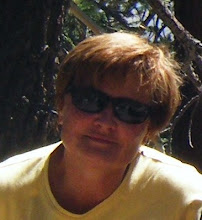Our Family's First Writer Moves On
 Her mother and mine were sisters, and with their husbands and young children moved from their family moorings in Michigan and arrived adrift at either end of California during the aerospace boom of the early 60's. Family now meant vast solitude between infrequent, brief, hasty hellos.
Her mother and mine were sisters, and with their husbands and young children moved from their family moorings in Michigan and arrived adrift at either end of California during the aerospace boom of the early 60's. Family now meant vast solitude between infrequent, brief, hasty hellos.She was the eldest of my 28 cousins, and once told me she hated the nickname Cappie. But the name stuck until many years later when she changed it to honor her grandfather, Charlie Valentine. She was, to my everlasting envy, tough, savvy, fun and fragile as a bubble. She was creatively secular, while I was, sigh, a struggling catholic. She read anything and everything like most people breathe. Our only adult visit came as a mistake. Her domestic life was, at the time, just as tumultuous as mine. But somehow we were able to squeeze in one of those infrequent, brief, hasty hellos. She pulled out stacks and stacks of manuscripts. Her passion was mystery writing. Why mysteries, I asked, thinking of the tediousity of Hercule Poirot and Sherlock Holmes. Life is one fucked up puzzle, she said laughing, so why not take a back seat and your characters can sort it out for you? Yeah, but writing is so...crummy a way to make a living and besides, I insisted, it always involves somebody somehow getting dished a lot of dead. And then with her characteristic older-cousin rank-pulling, It isn't the death dummy, it's the mystery I want, that's what matters, that's what I LOVE!!
I would say that Charlie's now enjoying a lot of a-ha moments right now. She slipped those surly bonds a few days ago. To the rest of us still here, it seems her departure was unfairly premature. Most of her early life's "manuscripts" were solved, more or less to satisfaction. She was ever the disciplined writer, it was the axis around which her life rotated. There's always something out there, she told me, that needs solving. Now Charlie will have lots of pain-free time to catch up with her namesake and investigate her own defining mystery in, as they say, hot pursuit.


 > The "other" ruby. Had to put this picture in. I have no way of guessing the value of all these rubies. Each one is about 30-40cm long and 20-25 cm wide, and perhaps upwards to 45 carats each. These are are the Tanzanian rubies. My favorite. Value has no meaning here, nor what the number on the gem scale says. It is rather the profound beauty of Earth's treasure I find so eternally enthralling. Add some facets and a broad visible spectrum and that treasure emits a symphony of photonic music!! Each ruby's "music" is unique, taking in only the light it needs to sing its own particular song!
> The "other" ruby. Had to put this picture in. I have no way of guessing the value of all these rubies. Each one is about 30-40cm long and 20-25 cm wide, and perhaps upwards to 45 carats each. These are are the Tanzanian rubies. My favorite. Value has no meaning here, nor what the number on the gem scale says. It is rather the profound beauty of Earth's treasure I find so eternally enthralling. Add some facets and a broad visible spectrum and that treasure emits a symphony of photonic music!! Each ruby's "music" is unique, taking in only the light it needs to sing its own particular song!






